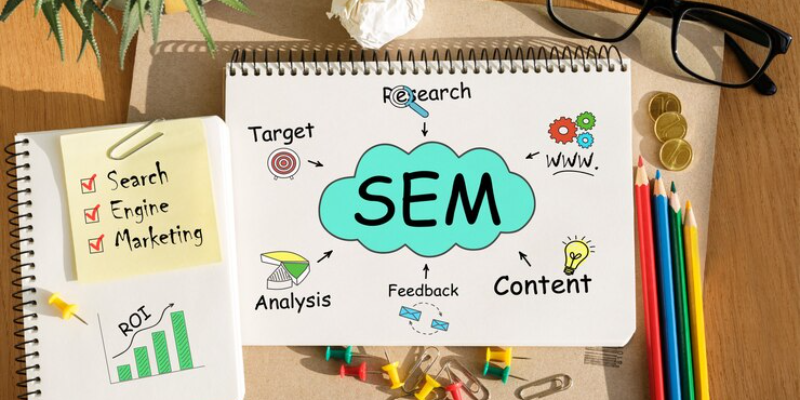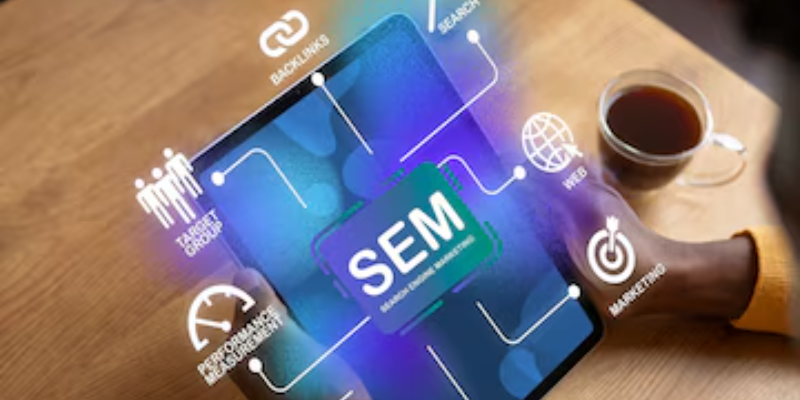

The modern world is a cut-throat competition for any business, let alone an e-business. Among them, the most useful is Search Engine Marketing or commonly known as SEM. SEM is not a tool for merely increasing traffic to a site; it is a tool that is used to optimise paid search to increase the exposure of your brand and attract new customers. What is SEM and how does it work? What are the benefits of SEM? How can you get started with SEM? These questions will be answered in this complete guide to search engine marketing.
Search Engine Marketing is one of the digital marketing techniques that is aimed at the promotion of websites by making them as accessible as possible to the users of search engines, mainly through paid links. Where SEO majorly deals with un-paid optimisation for better ranking, SEM employs paid advertising campaigns such as pay-per-click (PPC) for quick results. This makes SEM the perfect tool for any business that wants to get results as soon as possible and also get more audience.
Another major strength of SEM is that it offers the opportunity of advertising that is aimed at specific audiences. Unlike other forms of advertising, where a firm’s ads are aired to everyone, with SEM a firm can target specific segments of the population, geographic locations or even the time that they appear on the screen. This precision is helpful in channeling the marketing efforts to the target audience who are more likely to give their business, thus making SEM a cheap marketing strategy for any business.

1. Immediate Results and Quick ROI
Compared to SEO which may take around a year or more to show positive outcomes, SEM enables business organisations to monetise their web traffic within the shortest time possible. When a campaign has been created, ads can go live on search engines within the shortest time and the traffic to the website can begin within hours. This is especially useful for companies that wish to advertise specific products on a short-term bases or companies that require a short burst of traffic.
2. Targeted Advertising for Maximum Impact
This is because through SEM, business persons can post their ads in places that they wish and also target special groups of people such as the young, the female gender, etc. This level of targeting makes it possible that only the population of the people likely to be interested in your products or services will see your advertisement. For instance, instant advertisement can be based on the location of a local business, which means that all the ads will be displayed to potential customers only.
3. Enhanced Brand Visibility and Awareness
Even if users do not click on your ads, repeated exposure to your brand name and message at the top of SERPs helps to increase brand awareness. Over time, this can lead to improved brand recall and higher conversion rates as users become more familiar with your business.
4. Measurable Results and Analytics
Another benefit of SEM is the possibility of monitoring the results of the campaigns, which are run in real-time. Google Analytics and Google Ads have features that help them give details about some of the most essential indicators of effectiveness such as CTR, CPC, and conversion rates. Such data enables you to plan and make changes to your campaigns as and when to meet your targets and achieve great returns on investment.
5. Cost-Effective Marketing
SEM is flexible in that you are in control of your budget at all times. It is possible to specify daily budgets for your campaigns and fine-tune your bids as to achieve the maximum result in the shortest amount of time and with the least amount of money spent. Besides, since payment is made on the basis of cost per click, SEM can be more efficient as compared to other advertising techniques where payment is made regardless of the people’s interest.

1. Thorough Keyword Research and Selection
The foundation of any successful SEM campaign is thorough keyword research. It is essential to identify the keywords your target audience uses to search for products or services similar to yours. Utilise tools like Google Keyword Planner, Ahrefs, or SEMrush to discover high-performing keywords that balance search volume and competition well. Focus on short and long-tail keywords to capture a wide range of search queries.
2. Crafting Compelling Ad Copy
Your ad copy is the first impression potential customers will have of your business. It must be engaging, relevant, and compelling enough to encourage users to click. A good ad copy should communicate your unique selling proposition (USP) and include a solid call to action (CTA). For instance, if you're offering a limited-time discount, highlight this in your ad to create a sense of urgency.
3. Optimising Landing Pages for Conversions
Driving traffic to your website is only half the battle. Once users click on your ad, they should be directed to a landing page relevant to the ad content and optimised for conversions. The landing page should load quickly, be mobile-friendly, and have a clear and compelling CTA. Additionally, make sure that the content on the landing page matches the promise made in the ad to reduce bounce rates and increase conversion rates.
4. Utilising Ad Extensions for Greater Visibility
Ad extensions are a great way to enhance the visibility of your ads and provide users with more information. Sitelink extensions, for example, allow you to include additional links to specific pages on your website, such as product pages or contact forms. Callout extensions enable you to highlight special offers or features. In contrast, location extensions can show your business’s address and phone number, making it easier for local customers to find you.
5. A/B Testing and Continuous Optimisation
A/B testing is a critical component of any SEM strategy. By testing different versions of your ads, you can determine which elements are most effective in driving clicks and conversions. Experiment with headlines, ad copy, CTAs, and landing page designs to see what resonates best with your audience. Use the insights gained from A/B testing to optimise your campaigns and continuously improve performance.
6. Leveraging Remarketing to Re-Engage Visitors
Remarketing is a powerful tactic that allows you to target users who have previously visited your website but did not convert. By showing these users relevant ads as they browse other websites or social media marketing platforms, you can remind them of your brand and encourage them to return and complete their purchase. Remarketing can significantly increase your conversion rates and lower your cost per acquisition.
7. Focusing on Mobile Users
With the increasing number of users accessing the internet via mobile devices, ensuring that your SEM campaigns are optimised for mobile is crucial. This includes creating mobile-friendly ads and landing pages and using mobile-specific ad formats like click-to-call extensions. By targeting mobile users, you can capture a significant portion of the market that is often on the go and ready to make quick purchasing decisions.
8. Integrating SEM with SEO for Long-Term Success
While SEM provides immediate visibility, it should be viewed as something other than a standalone strategy. Integrating SEM with SEO services can create a powerful combination that drives short-term and long-term success. Use SEM to capture immediate traffic and test which keywords convert best. Then, incorporate these insights into your SEO strategy to improve your organic search rankings over time. Doing so can reduce your reliance on paid advertising and achieve sustainable growth.
However, as is often the case, SEM has its limitations as well. Targeting popular keywords is expensive, and if not well-controlled, one ends up using a lot of money and gets little to show for it. Here’s how to overcome some of the most common SEM challenges:
1. Managing Costs Effectively
First, maintain the costs under control by following a strict budget plan. There are other methods of controlling expenditure such as Google Ads’ automated rules that help you prevent campaigns from going over your budget. Moreover, the concentration on the specific keywords, which have a higher tendency to make a conversion rather than using the common keywords that may just attract traffic.
2. Staying Ahead of Competitors
The competitive nature of SEM means that you must constantly monitor your competitors’ activities. Use tools like SEMrush or SpyFu to analyse your competitors’ keywords, ad copy, and bidding strategies. By staying informed, you can adjust your campaigns to outmanoeuvre your competitors and capture more market share.
3. Improving Ad Quality and Relevance
Quality Score is an evaluation made by Google regarding your ads and their relevance, the quality of your landing page, and estimated CTR. This means that if the Quality Score is high, it is possible to get better ad placements at cheaper rates. To enhance the quality of your scores, ensure that you are placing relevant ads, optimise your landing pages and ensure that you keep on checking on your campaigns and making the needed adjustments.
This means that SEM is not static and is constantly changing due to the advancement in technology. SEM campaigns have deep integration with AI and machine learning to help improve their performances. It is possible to use AI to analyze data and determine which keywords will be the most effective and automatically adjust the bids or even generate effective ad text. Also, voice search is on the rise, and companies need to adjust their SEM tactics to satisfy the demand that is emerging.
Moreover, as privacy gets more valued, and laws like GDPR get more strict, businesses need to make sure that their SEM strategies follow all the laws and keep users’ data safe. This includes sharing information on how and what data is being collected from the users and allowing the users to decide on how their data is being used.
When used effectively, Search Engine Marketing is a powerful, dynamic tool that can drive significant business growth. By understanding the key benefits of SEM, implementing proven strategies, and overcoming common challenges, you can unlock the full potential of this marketing channel. As you move forward, remember that SEM is not just about driving traffic—it’s about creating meaningful connections with your audience and guiding them through the buyer’s journey to become loyal customers.
Whether you are a small business looking to increase local visibility or a large enterprise aiming to capture a global market, SEM offers the flexibility and precision needed to achieve your goals. Start building your SEM strategy today, and watch as your business reaches new heights of success.